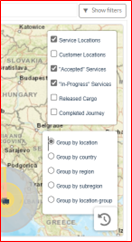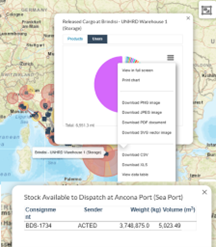RITA enables operators to visualize the project's country on a world map, displaying the movement and status of cargo throughout the operation. Various symbols and icons represent different aspects of cargo movement and storage. For instance, symbols like planes, trucks, and pack animals indicate the types of transportation used to move cargo. Similarly, other symbols represent warehouses, ports, and customer addresses.
Colored Circles
Colored circles in the map represent stock information in the cluster-operated facility:
Gray Circle represents the “Cargo Awaiting Collection”:
This section lists consignments pending collection either from the customer's address or a transshipment point. The Yellow Circle represents “Stock Available to Dispatch.” This section records all stock currently in storage. Even if items have been dispatched and receipt has been confirmed at the destination, the consignment remains counted as stock available to dispatch until it is officially released to the customer.
Red Circle represents “Expected Cargo Deliveries”:
This section includes cargo that the customer has yet to deliver, whether to a cluster-controlled warehouse and/or a transshipment point.
Blue Circle represents “Released Cargo”:
This section lists all consignments that have been partially or fully released to the final customer.
Show Filter
The show filter option at the top right corner of the map enables the RITA operator to filter the displayed data based on various criteria, such as Consignment Number, Organization, and Vehicle Category.
Selection Layers
The top right corner allows the users to toggle between layers of information to be displayed on the map. The different layers are listed below:
| Service Locations: | Displays the cluster-operated locations where services are being offered. |
| Customer Locations: | Shows the customer address registered in RITA. |
| Accepted Services: | Highlights service requests that the RITA operators have accepted. |
| In-Progress Services: | Displays requests that have been accepted and are currently underway. |
| Released Cargo: | Shows cargo that has been released to the final customer. |
| Completed Journey: | Displays all the dispatches completed in RITA as per the planned journey. |
Group By
Mapping allows RITA operators to group data further on the map based on geographic coordinates or addresses defined in RITA. The different grouping options provided enable users to view and analyze the operations data at varying levels of detail, depending on their specific needs. Various grouping options are listed below
| Location: | The warehouse, customer address, or transshipment point location is registered in RITA. |
| Country: | Country of operation |
| Region: | Broader regions within the country, for example, states or provinces |
| Sub-Region: | Smaller subdivisions within regions like districts, municipalities, and counties. |
| Location Group: | Custom-defined based on project- different state or district operations are usually registered under different location groups. |
Navigation Controls
The RITA operator will find the standard map control for zooming in and out and resetting the view at the top left corner of the page.
Timing
The clock symbol at the bottom right corner of the mapping page allows the RITA operator to scroll the date to see the history of transactions.
Options for viewing, printing and downloading maps/charts
Scrolling in the map will open dropdown menu with various options for viewing, printing, and downloading data from the map. Some of the options are listed below:
View Data table: This option enables RITA operator to view the underlying data of the chart in a tabular format within the interface. This provides a quick way to examine the numbers behind the maps/graphs
View the pie chart: Clicking on the released cargo allows RITA operator to see the pie chart for the released cargo by product and users.
Other options include viewing in full screen, printing charts, downloading PNG, JPEG, and SVG vector images, and downloading PDF, CSV, and XLS formats. For details, refer “Printing and downloading options” in chapter "Dashboard".




